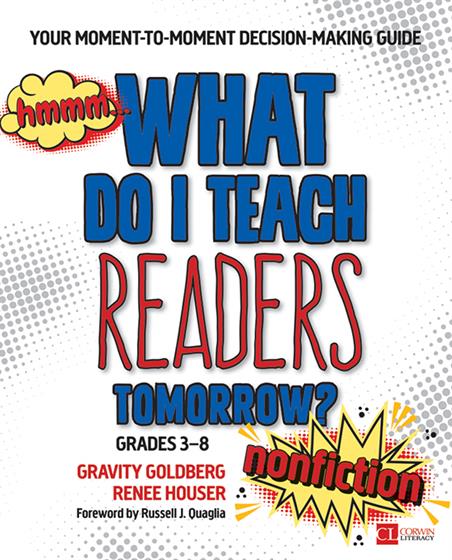Foreword
Acknowledgments
A Quick-Start Guide for Easy Access
Chapter 1: Each Classroom Moment Is an Instructional Decision
Acting Without a Script: Embracing Our Role as Improvisers
Answering the “What Next?” Question
Intentional Teaching: Decision Making With Students at the Center
Self-Reflection Questionnaire: What Type of Decision Maker Are You?
Decision-Making Styles
Three Common Teaching Habits
Let Students Be Your Guide
Getting Started: An Action Plan
Chapter 2: Decisions About Book Selection
Making a Choice to Read Aloud a Nonfiction Text
Narrative Nonfiction
Persuasive Nonfiction
Expository Nonfiction
Mash-Ups
5 Ways to Engage Students in Nonfiction Read Alouds
Chapter 3: Decisions About Reading Notebooks
Why We Really Use Writing as a Tool for Understanding
Current Reality: Why Students Write About Reading in School
Writing About Reading: An Important Tool for Readers and Their Teachers
How to Collect Thinking in Notebook Entries
Self-Reflection Questionnaire: Reading Notebooks
What We Might Let Go of When Asking Students to Write About Reading
Reading Notebooks: An Action Plan
Chapter 4: Decisions About Discussion
The Benefits: Making Meaning in Texts and Our Lives
Teach Students to Have Meaningful Conversations
Making Decisions Based on Student Conversations
Effective Nonfiction Conversation Characteristics
What We Might Let Go of When Asking Students to Talk About Their Reading
Self-Reflection Questionnaire: Student Conversations
Authentic Conversations: An Action Plan
Chapter 5: Decisions About Synthesizing Information
What Is Synthesis?
Why Is Synthesis So Important?
What Other Reading Skills Fit With Synthesis?
What to Look for When Students Synthesize Information
Thin-Slicing Students’ Synthesis Thinking
Decide What to Teach Next: Focus on Three Main Choices
Synthesis Across Texts
Synthesizing Information: An Action Plan
Chapter 6: Decisions About Understanding Perspectives
What Is Perspective?
Why Is Understanding Perspectives Important?
What Other Reading Skills Fit With Understanding Perspectives?
What to Look for When Understanding Perspective
Decide What to Teach Next
Reflecting With Students: How Understanding Perspectives Helps Us
Understanding Perspectives: An Action Plan
Chapter 7: Becoming Confident and Intentional Decision Makers
Appendices
Appendix A. Nonfiction Book Rating System
Appendix B. Some Favorite Nonfiction Texts
Appendix C. Clipboard Notes: Reading Notebook Entries
Appendix D. Clipboard Notes: Student Conversations
Appendix E. Synthesizing Nonfiction Texts
Appendix F. Clipboard Notes: Types of Thinking About Synthesizing Information
Appendix G. Understanding Perspectives in Nonfiction
Appendix H. Clipboard Notes: Types of Thinking About Understanding Perspectives
References
Index




